Community Gardens & Greenspace
School Grounds Greening
Many school grounds often consist mostly of hard surfaces and lack appealing outdoor spaces for student recreation, learning and interaction with nature. Without native trees, flowers and grasses, students are denied the benefits that come with playing, engaging and interacting with the natural environment around them. To address this, the Conservancy has proactively implemented since 2007 outdoor learning and play areas, which include a variety of natural and green features, at 57 high schools and elementary schools, and 11 early childhood centers in the Pittsburgh area. We've also advanced greening projects at six regional schools in Western Pennsylvania.
Early exposure to nature helps children in so many ways
Connecting children with nature is crucial for their development and well-being for many reasons. Nature play encourages physical activity, which is essential for healthy growth and development. It helps combat issues like obesity and promotes overall fitness. Time spent in nature has been shown to reduce stress, anxiety, and depression. It can improve mood, boost self-esteem, and enhance overall mental well-being. Nature provides a stimulating environment that fosters curiosity, creativity, and problem-solving skills. It enhances focus and concentration, which can lead to better academic performance.
Student benefits:
- Appreciation of nature
- Increased physical exercise
- Improved concentration and greater creativity
- Increased positive social interactions
Financial benefits:
- Energy savings
- Reduced maintenance costs
- Increased property values
Environmental benefits:
- Added habitat for birds, pollinators and other beneficial creatures
- Improved air quality
- Reduced stormwater overloads
Community benefits:
- Increased school involvement for parents
- Stronger sense of community
- Greener, healthier local environment
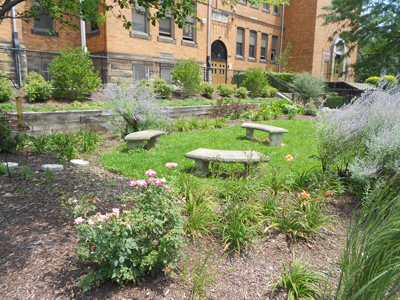
A direct connection to classroom instruction
Since 2007, our school grounds greening work has supported and enhanced a variety of different learning opportunities at various schools. This work provides a hands-on learning environment where students can engage in subjects like biology, ecology and agriculture, making theoretical knowledge more tangible and memorable. Students also gain an understanding of ecosystems, sustainable practices, and the importance of biodiversity, fostering a sense of environmental stewardship These improved spaces also enable teachers to incorporate hands-on nature learning experiences into their curricula.
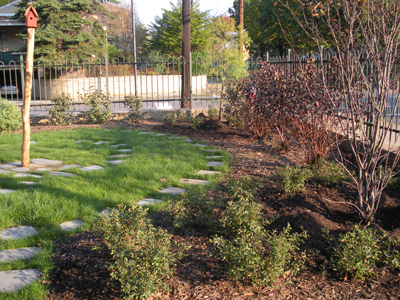
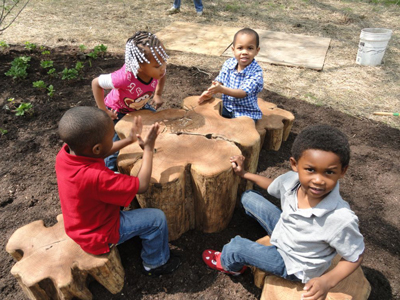
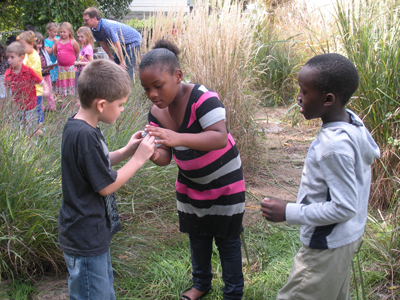
Our work with Pittsburgh Public Schools
The Western Pennsylvania Conservancy, the Grable Foundation and Pittsburgh Public Schools, worked to bring sustainable greenery to 57 different Pittsburgh Public High Schools and Elementary Schools. The project provided outdoor classrooms, natural play spaces and low-maintenance plantings to provide shade, landscape accents and natural points of interest for children. As part of the school grounds greening partnership, over 700 large trees and more than 9,000 shrubs and perennials were planted, many by students. In addition, the project has added 18 outdoor classrooms, six natural play spaces, five quiet reading and sitting areas, three food garden beds, a rain garden, a sensory garden and a butterfly garden.
Helping students in Early Childhood Centers thrive
Building upon the impact that the school grounds greening project had on Pittsburgh Public Schools, WPC placed emphasis on Early Childhood Centers that serve preschool-aged children in the City of Pittsburgh. Thanks to the generosity of PNC Foundation, we construct natural playspaces that can be used by centers for education and play. In many instances, ECC do not have available space for children to play and learn outside, but our school grounds greening projects have changed that at 11 locations throughout Pittsburgh.
Young learners are able to enjoy native greenery, flower-shaped chalkboards, climbing rocks and boulders, birdhouses, farmers market stands, stepping stone paths, mazes and much more. These spaces not only provide ecological services to support nature, but also encourage early childhood development in several ways, including enhancing physical skills and inspiring opportunities for creativity, imagination, problem-solving, discovery, observation, experimentation, and social interaction. The Conservancy continues to develop opportunities to empower and support teachers to discover creative ways to meet learning standards outside.
Planting trees and more at Barrett Elementary School in Homestead
Our work at Barrett Elementary in Homestead, Pa. was started from recommendations made in the Homestead green scan report. Inspiration for this project also came from the success of previous school grounds greening projects in Pittsburgh. Thanks to grants from PNC Foundation and Allegheny County Conservation District, we worked with students from Steel Valley School District to plant six ginkgo trees in front of Barrett Elementary in a specially designed tree trench, meant to capture, filter and slowly release stormwater into the drainage system.
Part of this project at Barrett Elementary included Conservancy staff working with Steel Valley High School STEM (science, technology, engineering, and mathematics) students, school leaders, local municipal officials and landscape architects to help plan and design additional green infrastructure to improve the grounds around the school. As part of the education process for this project, we took the STEM students and their teachers to Bear Run Nature Reserve and Fallingwater to study and experience how architecture, design and nature can work together.
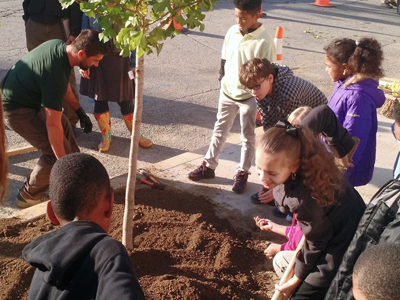
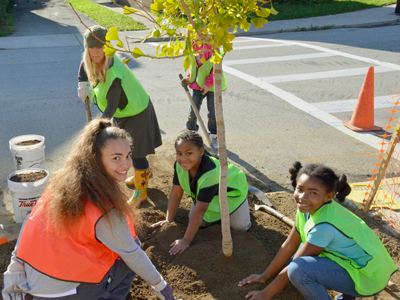
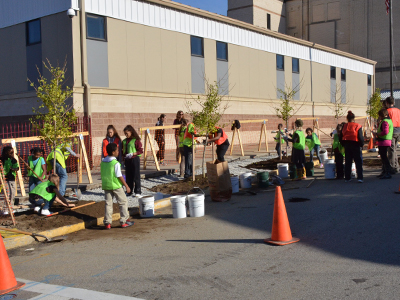
Watch this 45-minute webinar to learn more about WPC’s School Grounds Greening work.
For More Information:
Art DeMeo
Director of Community Greenspace Services
Western Pennsylvania Conservancy
800 Waterfront Drive
Pittsburgh, PA 15222
